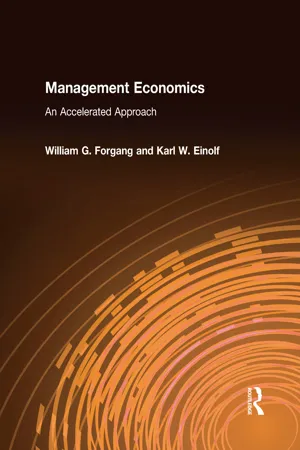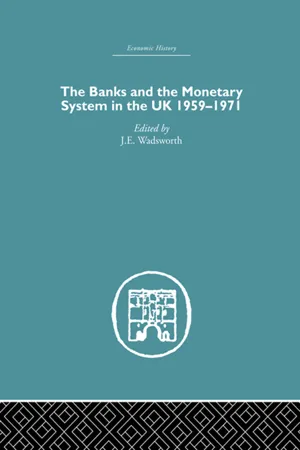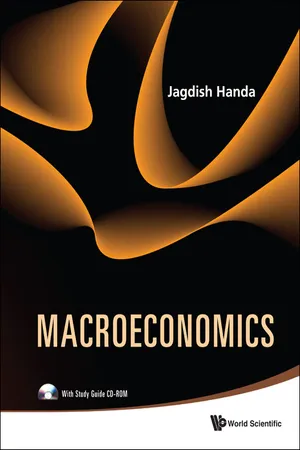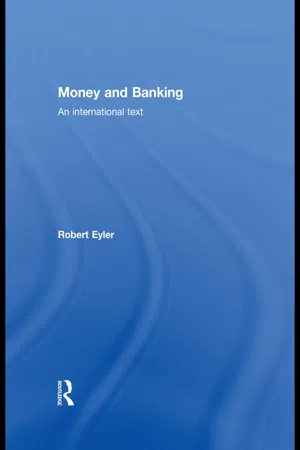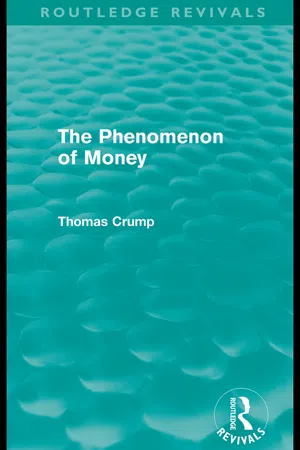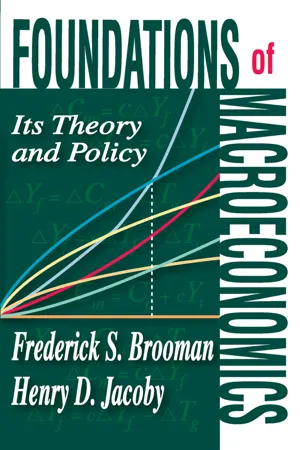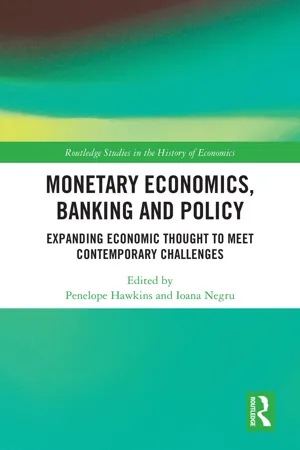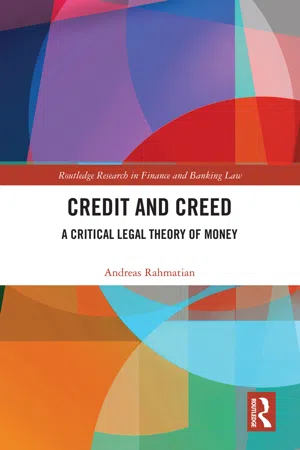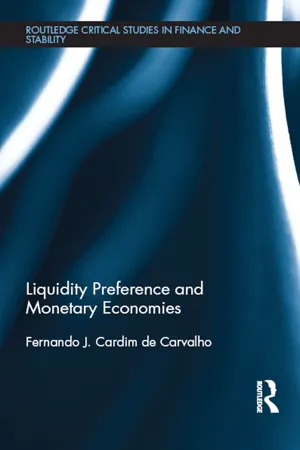Economics
Money Supply
Money supply refers to the total amount of money in circulation within an economy at a given time. It includes physical currency, such as coins and banknotes, as well as demand deposits and other liquid assets held by individuals and businesses. Changes in the money supply can impact inflation, interest rates, and overall economic activity.
Written by Perlego with AI-assistance
Related key terms
12 Key excerpts on "Money Supply"
- eBook - ePub
- W. Charles Sawyer, Richard L. Sprinkle(Authors)
- 2020(Publication Date)
- Routledge(Publisher)
2 Internationally, this definition of the Money Supply is known as narrow money.Other definitions of money are possible. There are a number of financial assets that are referred to as near monies that can be used as money in many circumstances. Near monies are highly liquid financial assets such as savings accounts, time deposits, and short-term government securities. In many cases, these assets cannot be spent as easily as can currency or a demand deposit at a local bank. An example of a near money is an account with a money market mutual fund. In the U.S., this is a common form of near money. In other countries, where this form of near money is less common, a large amount of near money is held in the form of time deposits. For the most part, near monies do not function as a medium of exchange but they can be readily converted into currency or demand deposits. For the U.S., M1 plus money market mutual funds and time deposits constitutes M2. In an international context, the term for M2 is called broad money.Ultimately, the supply of money within a country is the result of a process that we need to describe. In order to do this we will need to look at an important part of the Money Supply known as the monetary base (B). The monetary base (B) is composed of cash in the hands of theBOX 15.1WHAT IS THE SUPPLY OF MONEY?Even though the public can hold money for a variety of reasons, the supply of money that is relevant for the purposes of economic policy is a measure of money that will be used for economic transactions within a given period of time, such as a year. Unfortunately, in most countries such a perfect measure of the Money Supply does not exist. For example, in the U.S. neither M1 nor M2 is identical to the supply of money the public uses for short-run economic transactions. The primary reason why this is true is related to the existence of money market mutual funds. These funds can be used for transactions, as each account has limited check-writing capabilities. In addition, these accounts are also widely used as a parking place for funds between the purchase and sale of equities, bonds, and other long-term financial assets. As a result, M1 understates the amount of money that the public could use for short-run economic transactions, and M2 overstates this same amount. In this case, the central bank of the U.S. cannot know with certainty what the amount of money is that the public intends to use for short-run economic activities. To a greater or lesser extent, every country has this problem of defining what the relevant supply of money is. In the discussion that follows, we assume that there is a relevant supply of money under the central bank’s control. However, one should keep in mind that the supply of money in an economy is not as clear-cut in most cases as central bankers or those following the state of the economy might like. - eBook - ePub
Management Economics: An Accelerated Approach
An Accelerated Approach
- William G. Forgang, Karl W. Einolf(Authors)
- 2015(Publication Date)
- Routledge(Publisher)
a medium of exchange. The unit of account function means that goods and services are priced in money terms. The medium of exchange function means that goods and services are exchanged for money.Application Box 3.6The nation’s Money Supply (M1) in November 2005 was $1,372 billion.Source: www.economagic.com.Therefore, one component of the Money Supply is currency and coins. However, many purchases are completed by writing checks, and dollar balances in checking accounts (demand deposits) are the largest part of the Money Supply. Checking deposits and currency and coin are the largest components of the M1 definition of money.The Equation of ExchangeOne way to examine the relationship between the Money Supply and gross domestic product is through the equation of exchange (see Table 3.1 ).The equation of exchange is an identity. On the left side of the equation, the supply of money (M ) is multiplied by the velocity of money (V ). The velocity of money is the average number of times a dollar or deposit is used to complete transactions during a year. For example, assume individuals are paid weekly and spend the full amount before their next pay period. Under these restrictive assumptions, the velocity of money is 52. If individuals are paid monthly and spend the full amount on goods and services prior to the next pay period, the velocity is 12.Table 3.1 Equation of ExchangeMV = PT Where: M = Money Supply V = velocity of money P = price level T = number of transactions The left side of the equation of exchange is total expenditures. It is the Money Supply multiplied by the velocity. The right side of the equation is total receipts , which are the average price of goods and services (P ) multiplied by the number of transactions (T - J.E. Wadsworth(Author)
- 2013(Publication Date)
- Routledge(Publisher)
In particular, let us add, Money Supply in Britain has to be considered in the environment of UK financial institutions, especially banks. If the Money Supply is important, it is presumably because of its relationship to aggregate demand. As the Radcliffe Committee put it, the ‘relevance of the availability of funds to the pressure of total demand is what lies behind the supreme importance which is often attached to “the supply of money”’. A clear distinction needs to be drawn between the stock of money and its flow, and until recently attention has been directed almost entirely at the effects of the flow. Today it is being increasingly suggested that attention should be paid to the stock, and in particular to changes in the stock.In discussing the Money Supply, however, a satisfactory definition is a first essential. In one sense an appropriate definition depends upon the context in which Money Supply is to be considered. If related to aggregate demand, the definition has to be concerned with the spendability of money. Thus it should be associated primarily with money in the sense of something that can be spent immediately, as contrasted with near-money, which is moderately liquid but cannot be used directly for spending by the holder. An example of near-money would be funds deposited with a building society or similar undertaking. Much near-money is readily spendable, though not normally directly or immediately as with currency and most bank deposits, but only after some other operation to turn it into one of those forms. Moroever, as we shall see, if it is turned into spendable money it does not increase the total of final means of payment – that is to say, the ‘active’ Money Supply.In International Financial Statistics , published by the International Monetary Fund, money is by implication defined as currency and bank deposits, the figures for the United Kingdom including balances on deposit as well as current accounts. ‘Quasi-money’ – that is, near-money – is defined generally as ‘time and savings deposits and other liabilities of the monetary system that the user of the data may or may not wish to consider to be money’. Thus it is clearly indicated that any definition of the Money Supply is subjective, and depends upon the attitudes of users and their intentions. The figures recorded in International Financial Statistics are quite close to those given by the Central Statistical Office in its publication Financial Statistics . This, too, admits that ‘any definition of the Money Supply is arbitrary’. The Organisation for Economic Cooperation and Development, by implication, has accepted this point, as it was until recently publishing a series for the United Kingdom on a very narrow basis, but has now changed to one based on the Financial Statistics series. This widely accepted definition combines currency in circulation with the public with net deposits by UK residents with the whole of the banking sector,13 including both sterling and non-sterling current and deposit accounts. Table A8- eBook - ePub
Macroeconomics
(With Study Guide CD-ROM)
- Jagdish Handa(Author)
- 2010(Publication Date)
- WSPC(Publisher)
near-banks — i.e., those financial institutions in which the deposits perform almost the same role for depositors as similar deposits in commercial banks. Examples of such institutions are savings and loan associations and mutual savings banks in the United States (USA); credit unions, trust companies, and mortgage loan companies in Canada; and building societies in the United Kingdom (UK). The incorporation of such deposits into the measurement of money is designated by the symbols M3, M4, etc., or by M2A (or M2+), M2B (or M2++), etc. However, the definitions of these symbols have not become standardised, so that their definitions remain country specific.Financial institutions in the economyFinancial institutions are firms involved in the process that determines the Money Supply and interest rates. They also intermediate between the borrowing and lending processes in the economy. In practical terms, financial institutions include the central bank, commercial banks, near-banks such as credit unions, trust companies, brokerage companies, postal banks, pension funds, etc. They do not engage in the production or consumption of commodities but receive funds from some sources and channel them to others (i.e., invests them).2.2 Money Supply and Money StockMoney is a good, which, just like other goods, is demanded and supplied by the various participants in the economy. There are a number of determinants of the demand and supply of money. The most important of the determinants of money demand are national income, the price level, and interest rates, while that of the Money Supply is the behavior of the central bank of the country which is given the power to control the Money Supply and bring about changes in it.The equilibrium amount in the market for money specifies the money stock , as opposed to the Money Supply , which is a behavioral function. These are depicted in Figure 2.1a with the nominal quantity of money M on the horizontal axis and the market interest rate r on the vertical axis. The Money Supply curve is designated as M s and the money demand curve is designated as M d . The equilibrium quantity of money is . It equals the quantity of money supplied at the equilibrium interest rate . Note that the quantity is strictly speaking not the Money Supply, which has a curve or a function rather than a single value. However, is the money stock that would be observed in equilibrium.1 - eBook - ePub
Money and Banking
An International Text
- Robert Eyler(Author)
- 2009(Publication Date)
- Routledge(Publisher)
Why? While the official reasoning was vague; most likely it was due to a lack of volatility in M 3 money. M 2 is now considered that measure. Money faces a market for its distribution that follows economic incentives like any other good or service. Its production is partially centralized; if the only measure of money was currency, the central bank would be the monopoly provider. Since money is also a store of value, banks help round out the quantity of money supplied at a given interest rate due to their profit incentives in either storing or lending money. This chapter links the supply side of the money market to its demand side. The first section of Chapter 9 breaks down the demand for money, the motives for holding cash in a non-interest bearing form. These motives are associated primarily with the work of John Maynard Keynes, an economist who began a revolution in monetary theory. Second, a money demand function is hypothesized, where money demand is linked to consumption and savings directly. How the financial and goods markets interact has much to do with how people demand money. Income is used to both consume and save, which stimulates money demand for both these acts. Next, the Money Supply curve is derived and equilibrium in the money market is shown. This equilibrium brings together banks and the economy’s circular flow; central banks change the entire Money Supply and assume banks will act through profit-maximizing incentives to help achieve monetary goals. There are multiple ways in which monetary policy affects the macroeconomy; these transmission channels are linked to the interest rate channel discussed in Chapter 8. In Chapter 10, the connection between inflation and unemployment is used to suggest that central banks ultimately form policy to affect one or both of these macroeconomic variables - eBook - ePub
- Thomas Crump(Author)
- 2011(Publication Date)
- Routledge(Publisher)
5 The supply of moneyThe supply of money provides the key to the understanding of many different kinds of monetary phenomena. The subject is beset by paradox at every stage. At the most elementary level, it is tied up with the question of the origins of money (also considered at the beginning of chapter 7 below), which has never received a satisfactory answer. The problems arising out of the supply of money are quite different for the two types of money introduced in chapter 1 . For the first type, specie, they are at first sight somewhat intractable. For the second type, scriptural money, the aggregate of monetary transactions automatically maintains the supply of money.The supply of specie
For specie the need is first to create, and then to maintain, a stock of money sufficient for the transactions to be carried out within the sphere of payment. In this case any transactor assures his own individual supply of money by successfully engaging in any or all of the monetary strategies which together determine the recognized use of money. But the aggregate of these transactions, although it ensures the circulation of money, does nothing to assure the supply of money to the sphere of payment.The point, which is extremely important for further analysis, can be illustrated by referring to Fisher’s equation:1MV=PT where M is the total stock of money, V the velocity of circulation, P the price level, and T the output of interests which form the counterpart for all transactions entered into.2 Now in theory M can be maintained perfectly constant, at any level, simply by adjusting V and P - eBook - ePub
- Jagdish Handa(Author)
- 2002(Publication Date)
- Routledge(Publisher)
For 1983:01–1990:06, Baghestani and Mott concluded from their cointegration-ECM results that the economy’s adjustments to the long-run relationship occurred through changes in the Money Supply and the interest rate, rather than in the monetary base. Comparing their findings across their three periods, changes in the central bank policy regime, such as targeting monetary aggregates or interest rates, are extremely important in determining the Money Supply function in terms of both its coefficients and whether there even exists a long-run relationship. Further, even regulatory changes such as permitting, after 1980, the payment of interest on checkable deposits can shift the Money Supply function.CONCLUSIONS
The supply of money in an economy is critical to its macroeconomic performance, so that most countries have allocated control of it to a central bank. Therefore, the theory of Money Supply for any given economy has to start with the knowledge of whether or not its central bank exogenously determines the Money Supply, thereby cancelling out any undesired changes in it induced by other factors in the economy. If it does so, the final determinant of the Money Supply is central bank behaviour. However, if it allows other factors some role in changing the Money Supply, a wider analysis of the Money Supply becomes applicable, and the behaviour of the public and of financial institutions also needs to be studied.The theories of Money Supply can be specified as either mechanical or behavioural. In practice, most empirical studies combine both approaches in deriving their estimating equations. These studies show that, over time, changes in the monetary base are the main element in changes in the Money Supply. However, over the business cycle, changes in the currency and the reserve ratios also play a very significant role, with the result that their determinants also need to be incorporated into the estimating equations. These determinants include a variety of interest rates in the economy, as well as national income. The estimated Money Supply functions, especially for M1, usually show negative elasticities with respect to the central bank discount rate and positive ones with respect to the Treasury bill rate. - eBook - ePub
Foundations of Macroeconomics
Its Theory and Policy
- Frederick S. Brooman(Author)
- 2017(Publication Date)
- Routledge(Publisher)
Chapter 10 . However, an excess or shortfall of the demand for money against the supply of it is likely to upset any previously existing equilibrium in the rest of the economy, while disturbances in the markets for commodities and labor will themselves upset the balance on the monetary side. What, then, determines the demand for money? To answer this question, it will be convenient to distinguish between the demand for it as a means of payment and the demand for it as a liquid asset (this is, of course, a highly artificial distinction, extremely difficult if not impossible to apply in practice, but it is adopted here merely as an expository device).2. The Transactions Demand for Money
Until the period between World Wars I and II, most economists paid little attention to the demand for money as an asset on the ground that rational individuals would hold only the amounts they needed to make current payments. Since money does not yield interest, an individual who found himself with more of it than he needed for payments purposes would use the surplus to acquire income-yielding assets such as bonds, stocks or real estate; he might even increase his consumption rather than continue to hold a “barren” asset. Consequently, it was argued, the usual effect of an increase in the supply of money would be to raise the level of prices, since the additional money would be financing an increase in the demand for goods and services. Conversely, a reduction in the Money Supply would cause people’s holdings to fall below the level needed for payments, and their efforts to restore their money balances by selling other things would force the price level down. This view, emphasizing money’s means-of-payment function to the exclusion of its liquid-asset role, was formalized as the “Quantity Theory of Money.”6 - eBook - ePub
Monetary Economics, Banking and Policy
Expanding Economic Thought to Meet Contemporary Challenges
- Penelope Hawkins, Ioana Negru(Authors)
- 2022(Publication Date)
- Routledge(Publisher)
The main role that the Money Supply plays in the analysis of effective demand is in the determination of the rate of interest. It is the supply of money in conjunction with its demand (aka liquidity preference) that together determine the interest rate. However, it is important to note that it is not the total quantity of money that plays a role in determining interest rates, but, rather, the quantity of money remaining after the transactions demand for money has been satisfied (see, for example, ibid., p. 74).The clearest discussion of the role of the Money Supply and its exogeneity occurs in Chapter 19 where Keynes examines the impact of changes in money wages to demonstrate that wage flexibility will not cure unemployment. In this context, an important mechanism that allows changes in money wages to influence the level of employment operates through the Money Supply. According to Keynes, a reduction in money wages “accompanied by some reduction in prices and in money-incomes generally, will diminish the need for cash for income and business purposes” (ibid., p. 263). This reduced transactions demand for money will make more money available for speculative purposes, which will reduce the rate of interest, and therefore, ceteris paribus will increase the level of investment and subsequently of output and employment. This effect of a reduction in wages is known in the literature as the Keynes effect (Kriesler 1997 , Docherty 2005 , pp. 13–5). As Keynes admits, it depends on the exogeneity of money as, “If the Money Supply is itself a function of the wage- or price-level, there is indeed, nothing to hope in this direction.” (ibid., p. 266). In other words, Keynes here considers and rejects the possibility of endogenous money. “But if the quantity of money is virtually fixed, it is evident that its quantity in terms of wage-units can be indefinitely increased by a sufficient reduction in money-wages” (ibid., p. 266). However, Keynes argues that monetary policy increasing the Money Supply would achieve the same result, without the negative side effects. Both of these aspects of the argument suggest that Keynes considered the Money Supply to be exogenous, under the control of the monetary authority in The General Theory - eBook - ePub
Credit and Creed
A Critical Legal Theory of Money
- Andreas Rahmatian(Author)
- 2019(Publication Date)
- Routledge(Publisher)
A proper supply and demand model would have to be three-dimensional if it wanted to take into account that money is an interim commodity which is interposed between the seller’s real commodity (for example, a ballpoint pen), and the real commodity the seller later obtains as a buyer (a loaf of bread). This commodity ‘money’ is not neutral, but comes at a cost, as any commodity. The provision of money involves the cost of holding money, in cash, or in a current account, for example, and, particularly, interest. 79 One can see that money is a separate commodity with a cost element, especially interest, if one studies the modern Money Supply or money creation mechanism, as was discussed in Chapter 2. Since in the modern monetary system money is a debt which almost invariably attracts interest, this aspect is extremely important particularly in microeconomic analysis because the interest that money entails influences the development of prices significantly, independently from the market equilibrium conception of the microeconomic barter model. A loan, thus bank money, with interest requires the seller of goods to increase the price to cover capital and interest of the loan he is bound to repay. Since all money is debt with interest, someone must always be debtor and therefore prices become increased to cover the loan and interest, whereby the interest is the price of credit (or debt). 80 How economists develop a model to encapsulate this relation between quantit y of real goods, money as a commodity in its own right, and price in a true sales transaction (not just in a conceptual reduction to barter that eliminates money) must be left to them. Perhaps the x -axis (or z -axis) would be the quantity, the y -axis the cost/benefit of the money used for payment, and the z -axis (or x -axis) the price that is (or may be) dependent both on the quantity of the commodity (or conversely) and on the cost and benefit of the money involved - Richard Coghlan(Author)
- 2014(Publication Date)
- Routledge(Publisher)
One area in which the MABP is deficient is in its neglect of the process through which the Money Supply actually comes into existence. Once this is taken into account, the analysis needs to be further qualified. This does not deny that the balance of payments is a monetary phenomenon, nor that the equilibrium conclusions of the international monetarists still hold; what it does do is substantially qualify the adjustment mechanism that has been widely referred to in the literature. This is important because if the monetary approach is to have practical value, it must be capable of describing disequilibrium situations, and the path and timing of any return towards equilibrium.Given the present organisation of the monetary system in the United Kingdom, and in most other countries, the Money Supply is not controlled directly by restricting the availability of bank reserve assets, but through changing the price at which bank reserves will be supplied. This approach, combined with the political sensitivity of interest-rate movements, means that the domestic contribution to the supply of money will be determined by the quantity of credit (to all customers) provided by the banks. This process was described above for a closed economy. It was emphasised that there is no necessary requirement for the equilibrium demand for money to change by the same amount as the demand for bank credit, and therefore the supply of money, though the motives for demanding bank credit should also result in expenditures (on goods and securities) that will have the effect of raising the demand for money. The speed with which equilibrium is achieved depends critically on the form the expenditures take. This model now needs to be extended to allow for external currency flows influencing the Money Supply, and adjustment through the balance of payments.The idea that there can be disequilibrium between the demand for and supply of money is not new, and, of course, underlies the monetary approach to the balance of payments. However, there are important implications for this model once we recognise the significance of the demand for credit in determining the Money Supply, and that there is no need for this to be matched, in the short term, by an equilibrium demand for money, or if it is, only because of the expenditures facilitated by the credit creation. It should be helpful to consider one or two examples. In all cases we start from a position of universal equilibrium, and assume there are no exogenous shifts in real variables (apart from an increase in credit demand).- eBook - ePub
- Fernando J. Cardim de Carvalho(Author)
- 2015(Publication Date)
- Routledge(Publisher)
managed money, as in contemporary systems.8 In the gold exchange standard, by contrast with the “classic” gold standard, a representative of gold – paper money issued by the Bank of England – circulates instead of gold or alongside it. Of course, the need to maintain convertibility imposed limits on the ability of the Bank to issue paper money, but those limits could be made more or less elastic if necessary.9 In the post-publication debates around the GT with Bertil Ohlin, Keynes was at pains to clarify his view that while money (in the form of bank deposits) was created mostly as a result of credit operations, it was the demand and supply of money that interested him, not the operation of the credit market per se. In fact, he insisted that confusing credit with money was at the root of the inability of his opponents in this matter to understand the theory of liquidity preference. Keynes’s side of the debate with Ohlin is reproduced in CW 14.10 In fact, that had always been Keynes’s view. In his Tract on Monetary Reform, when Keynes was still “as orthodox on the subject of the Quantity Theory as any earlier economist, and more orthodox than many” (Kahn 1984: 53), he held, as he actually did on every occasion, that setting the interest rate was the instrument used by monetary authorities to control the amount of liquidity in the economy:It is desirable … that the whole of the [bank] reserves should be under the control of the authority responsible for this, which, under the above proposals, is the Bank of England. The volume of paper money, on the other hand, would be consequential, as it is at present, on the state of trade and employment, bank-rate policy and the Treasury bill policy. The governors of the system would be bank-rate and Treasury bill policy, the objects of government would be stability of trade, prices, and employment, and the volume of paper money would be a consequence of the first (just – as I repeat – as it is in the present
Index pages curate the most relevant extracts from our library of academic textbooks. They’ve been created using an in-house natural language model (NLM), each adding context and meaning to key research topics.

